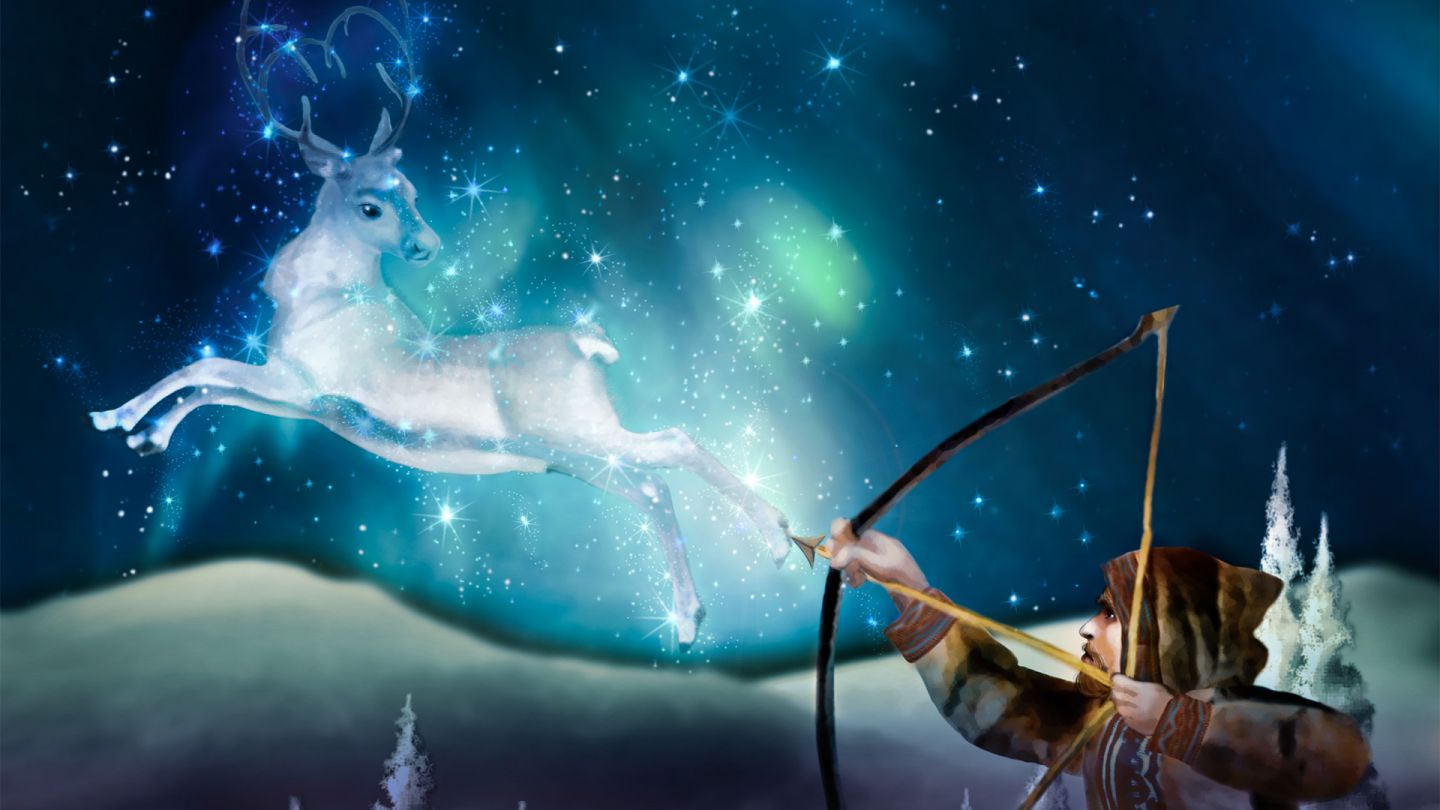Reindeer have always held a special place in the stories and traditions of the Arctic, from the Sámi in northern Scandinavia, to the epic poetry of the Finns, to people around the world.
More than just a source of food and fur, reindeer have always been part of the myths and tales of Northern people around the world. The Sámi believed the reindeer came from the Sun Himself and Finns told stories of clever artificers crafting reindeer by hand. And the Innus spoke in hushed tones of the dark and terrible Caribou House far in the North.
Rudolph, the destroyer of worlds
The Sámi people who inhabit northernmost Europe are not one homogeneous group with only one language and one culture. The history of the Sámi is rich with many cultural traditions and customs as well as stories and myths about their antlered friends, the reindeer. For more on Sámi people, their history and culture, check out Siida – the Sámi Museum & Nature Centre.
Reindeer are one of the latest wild animals to be domesticated, which happened about 3,000 years ago. Sámi traditions of where reindeer came from and why some are wild and others not range from fables to epic tales of gods and man. One story is that there were once two reindeer owned by sisters. The reindeer would roam in the wild but always return to be milked by the sisters. While one sister was gentle and caring for her reindeer, the other was harsh and left bruises and scabs. Finally, the mistreated reindeer had enough, vowing to flee to the wilderness and never return. Wild reindeer are descended from this reindeer, and the meek domesticated reindeer from the other.
Another tradition states that the Sun owned a cosmic reindeer herd, and He was pulled in a sledge around the world. Early in the year, the sledge was pulled by a strong bear, making the Sun bright and powerful. But He replaced his bear with a reindeer bull, then a reindeer cow, as the year progressed, causing the Sun to be weaker and weaker until it vanished entirely in winter. The daughter of the Sun, Njaveseatni the Sun Maiden, eschewed celestial suitors and married a man from Earth, and her dowry was part of the Sun’s reindeer herd.
One ancient Sámi story tells of a constellation in the night sky—a hunter with his bow aimed at the Cosmic Reindeer in an eternal hunt. When the arrow finally lands, and the Cosmic Reindeer falls, the world as we know it will end.

Franken-reindeer
Finns and Karelians also had their fair share of reindeer tales and songs, like the Songs of Vaadin. Vaadin (which is also the name for a female reindeer) was created by Seppo Ilmarinen (of Finnish epic poem Kalevala fame) to assist him on his journeys for knowledge. Seppo was an immortal artificer capable of crafting anything. Songs of Vaadin’s adventures were and still are sung by Finnish shamans.
Vaadin was crafted with bones of stone, flesh of moss and skin of birch bark. Seppo gave her lichen to eat, mead to drink, and she carried him far and wide in search of the knowledge and components necessary to create many magical items.
Other hand-crafted reindeer from Finnish mythology are not so glorious and noble. In the Kalevala, the reindeer created by the villainous Hiisi has a head and flesh of rotten wood, antlers of willow branch, and other bodies parts crafted from swamp plants and materials.

Around the world in 1 night (or 10,000 years)
Talk to a child just about anywhere in the world, and they can tell you some stories of Santa Claus and his reindeer. How they fly, how they travel at supersonic (and possibly faster-than-light) speeds in order to deliver Christmas gifts to boys and girls all over the world. Talk to their great-grandparents, especially those from northern climes, and you might get hints of altogether different stories.
In Mongolia, the Dukha (Tsaatan) are among the last nomadic reindeer herders in the world, with only about 40 families remaining. These families have kept up the stories and traditions of their people. One tradition might be the origin of flying reindeer: deer stones. Carved from granite, some deer stones tower at over 4 meters tall, with markings facing east. These markings show reindeer leaping through the ear, often with the sun between their antlers.
In Canada, where reindeer are wild and called caribou, an Innu man once fell in love with a caribou woman. He became a caribou himself and master of all caribou. If an Innu doesn’t follow the traditional hunting rituals to show respect for animals, the Caribou Master would keep animals out of the hunter’s path. The Caribou Master lived in a remove dangerous land, in a house surrounded by a deep layer of discarded antlers.

The West Greenland Inuits believed that when a person died, they would either hunt marine animals in the underworld or travel to the sky to hunt spiritual caribou forever and forever.
What did we just say about hunting reindeer in the sky?
In the far-east of Russia, the Koryak people of Kamchatka Krai tell the story of how the Creator traveled to the stars to bring the antlered animal to Earth for humans. Like the Sámi people, the Koryak also craft drums of reindeer hide, and shaman use them in mystical rituals.
In what is now Kyrgyzstan, the tribes used to believe reindeer were their totems, a respected animal that spiritually represented their family or clan. The Native American tribe Ojibways and ancient Norwegians also held reindeer as their familial or clan totems.
Reindeer and the local culture around them are just one of the many reasons to visit Lapland in the winter.
Looking for more legends? Check out the dark side of the Northern Lights.



